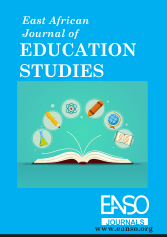Effect of Differentiated Instructional Approach on Learners' Participation and Academic Achievement in Biology in Public Secondary Schools in Mbeere North Sub-County, Kenya
Résumé
Secondary school education forms the academic foundation for the acquisition of knowledge in higher institutions. Science Education is the bedrock for technological advancement in Kenya and the world at large. Biology is a key science subject and forms the foundation of various fields; therefore, it is an essential discipline. The performance of students in Biology has generally been low for the last few years. The ordinary Conventional Instructional Approach used by teachers in increasingly diverse classrooms may have contributed to the minimal performance. This study aimed to assess the effect of the Differentiated Instructional Approach (DIA) on Learner Participation and Academic Achievement in Biology in Public Secondary Schools. Quasi-Experimental Research Design was used in particular, Solomon Four Control Group Design. The target population was 2405 form two Biology students. Purposive sampling was used to select 8 Co-educational County Secondary Schools with a sample size of 360 students. Simple random sampling was used to select and assign the participating schools to Experimental and Control groups. Descriptive statistics was used to analyse the data, while the Statistical Package for Social Sciences (SPSS) software version 26 was used for data analysis. The results showed that there was a statistically significant difference in all three hypotheses, with the first objective giving (F117.220, p<0.05), the second objective giving (F 54.049, p ˂ 0.05) while the third objective gave (F 65.417, p < 0.05) significant values. The results indicated that learners subjected to the Differentiated Instructional Approach did better than those instructed using Conventional Teaching Approaches. The study also concluded that DIA improved learners' Participation and Academic Achievement. The findings of this study would be significant to curriculum developers, educators, administrators and will also contribute to the knowledge base for the Differentiated Instructional Approach, forming the basis for further research
##plugins.generic.usageStats.downloads##
Références
Adebayo, A. S., & Shumba, C. B. (2014). An Assessment of the Implementation of Differentiated Instruction in Primary Schools, Kabwe District, Zambia. European Scientific Journal, 10(7).
Abramovich, S., Grinshpan, A. Z., & Milligan, D. L. (2019). Teaching mathematics through concept motivation and action learning. Education Research International, 2019.
Ambrose, S. A., Bridges, M. W., DiPietro, M., Lovett, M. C., & Norman, M. K. (2010). How learning works: Seven research-based principles for smart teaching. John Wiley & Sons.
Dimkpa, D. (2015). Teachers' Conduct in the 21st Century: The Need for Enhancing Students' Academic Performance. Journal of Education and Practice, 6(35), 71-78.
Dixon, F. A., Yssel, N., McConnell, J. M., & Hardin, T. (2014). Differentiated instruction, professional development, and teacher efficacy. Journal for the Education of the Gifted, 37(2), 111- 127. https://doi.org/10.1177/0162353214529042
Fraenkel, J. R., Wallen, N. E., & Hyun, H. H. (2012). How to design and evaluate research in education (Vol. 7, p. 429). New York: McGraw-Hill.
Gopalan, M. R. (2020). Use of quasi-experimental research designs in education research: Growth, promise, and challenges. Review of Research in Education, 44(1), 218-243.
Hamroev, A. R. (2019). Modelling activities of teachers when designing creative activities of students. European Journal of Research and Reflection in Educational Sciences, 2019.
Ismajli, H. &, (2018). Differentiated Instruction: Understanding and Applying Interactive Strategies to Meet the Needs of All the Students. International Journal of Instruction, 11(3), 207-218
Kubat, U. (2018). Identifying the individual differences among students during the learning and teaching process by science teachers. International Journal of Research in Education and Science, 4(1), 30-38.
Mai, N. (2020). Testing the Effectiveness of Transfer Interventions Using Solomon Four-Group Designs. Education Sciences, 10(4), 92.
Muthomi, M. W., & Mbugua, Z. K. (2014). Effectiveness of differentiated instruction on secondary school students achievement in mathematics. International Journal of Applied, 4(1), 116-128.
Santangelo, T., & Tomlinson, C. A. (2012). Teacher educators' perceptions and use of differentiated instruction practices: An exploratory investigation. Action in Teacher Education, 34(4), 309- 327. https://doi.org/10.1080/01626620.2012.717032
Shuttleworth, T. J. (2009). Arachidonic acid, ARC channels, and Orai proteins. Cell calcium, 45(6), 602-610.
Thakur, K. (2014). Differentiated instruction in the inclusive classroom. Research Journal of Educational Sciences. ISSN, 2321, 0508.
Tomlinson, C. A. (2013). Assessment and student success in a differentiated classroom. Ascd.
Tomlinson, C. A. (2017). How to differentiate instruction in academically diverse classrooms. ASCD.
Wang, M. T., & Eccles, J. S. (2013). School context, achievement motivation, and academic engagement: A longitudinal study of school engagement using a multidimensional perspective. Learning and Instruction, 28, 12-23.
Copyright (c) 2024 David Kariuki Kanyugi, Denis Obote, PhD, Shadrack Munanu, PhD, Marciano Iguna, PhD

Ce travail est disponible sous la licence Creative Commons Attribution 4.0 International .




























